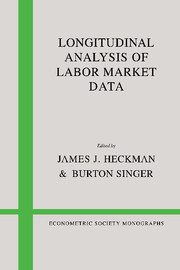Book contents
- Frontmatter
- Part I. Econometric studies
- 1 Heterogeneity, omitted variable bias, and duration dependence
- 2 Social science duration analysis
- 3 Interpreting empirical models of labor supply in an intertemporal framework with uncertainty
- 4 Alternative methods for evaluating the impact of interventions
- Part II. Statistical studies
- Part III. Sociometric studies
- Name Index
- Subject Index
4 - Alternative methods for evaluating the impact of interventions
Published online by Cambridge University Press: 05 January 2013
- Frontmatter
- Part I. Econometric studies
- 1 Heterogeneity, omitted variable bias, and duration dependence
- 2 Social science duration analysis
- 3 Interpreting empirical models of labor supply in an intertemporal framework with uncertainty
- 4 Alternative methods for evaluating the impact of interventions
- Part II. Statistical studies
- Part III. Sociometric studies
- Name Index
- Subject Index
Summary
The problem and an overview of solutions to it
This chapter considers the problem of estimating the impact of interventions in the presence of selection decisions by agents. For specificity we focus on the problem of estimating the impact of training on earnings when the enrollment of persons into training is the outcome of a selection process. The analysis of training presented here serves as a prototype for the analysis of the closely related problems of deriving selection-bias-free estimates of the impacts of unionism, migration, job turnover, unemployment, and affirmative action programs on earnings.
This chapter investigates the prior restrictions needed to secure consistent estimators of the selection-bias-free impact of training on earnings. We examine their plausibility in the light of economic theory.
We present assumptions required to use three types of widely available data to solve the problem of estimating the impact of training on earnings free of selection bias: (1) a single cross section of post-training earnings, (2) a temporal sequence of cross sections of unrelated people (repeated cross-section data), and (3) longitudinal data in which the same individuals are followed over time. These three types of data are listed in the order of their availability and in inverse order of their cost of acquisition. Assuming random sampling techniques are applied to collect all three types of data, the three sources form a hierarchy: Longitudinal data can be used to generate a single cross section or a set of temporal cross sections in which the identities of individuals are ignored, and repeated cross sections can be used as single cross sections.
- Type
- Chapter
- Information
- Longitudinal Analysis of Labor Market Data , pp. 156 - 246Publisher: Cambridge University PressPrint publication year: 1985
- 316
- Cited by

